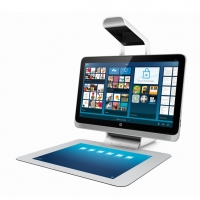Blending the Physical and Digital Worlds

We often hear parents complain that kids today don’t get as much exposure to physical games and activities in the way we did growing up. While there is truth to this, the digital world has obviously given them a lot of exposure and opportunities, helping promote a more well-rounded growth.
What is exciting is to see more of the physical and digital worlds coming together. This blending is not something new—companies such as Microsoft have already been researching quite a bit in this space for motion-sensing devices and gaming consoles. However, this technology is now steadily stretching into domains beyond sports and entertainment.
HP gave the combination the name “blended reality,” meaning objects are able to move from the physical to the digital world and back with ease. The company has an all-in-one PC, Sprout, that uses a 3D camera system, touch mat, and projector to bring its blended reality vision to life. Others in the industry call this interaction between the physical and digital the “phygital” world, and this technology also has the potential to help businesses improve shopping experiences by letting consumers visualize how products can fit into their lives.
Education is another field that is starting to benefit from the growth in this space. Some iPad applications let users merge their creativity and physical motor skills with the digital world. A demo video from Osmo, an educational accessory that works with iPads, shows a kid tracing her dad’s picture, giving it new touches, and sharing it with her grandma. This ability opens up an amazing number of avenues in which apps can potentially be used to enhance the learning process while still helping children develop motor skills and imagination.
Another technology taking shape along these lines is augmented reality, which means combining the physical and digital worlds. For example, one day, you may be able to touch your car’s window while driving and zoom in on an object far away. Other technologies that will play a major role in this space are the Internet of Things and big data, as these two will further expand the scope and use case scenarios for blended reality.
While it is exciting to see several of these new technologies take shape, it is also exciting to see how all these technologies will be able to work together—which itself offers a very promising future for blended reality.

